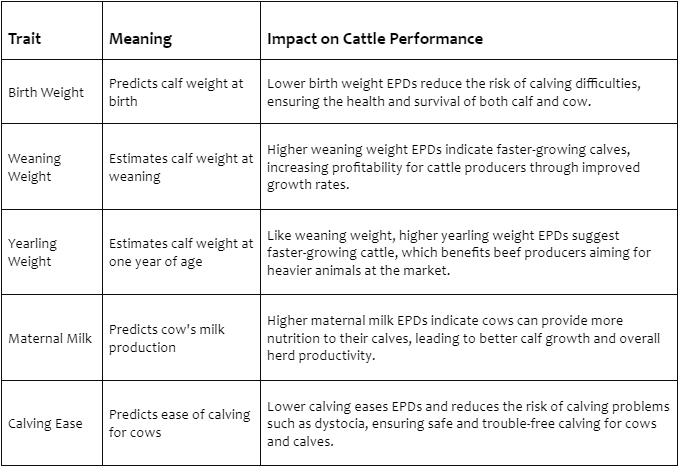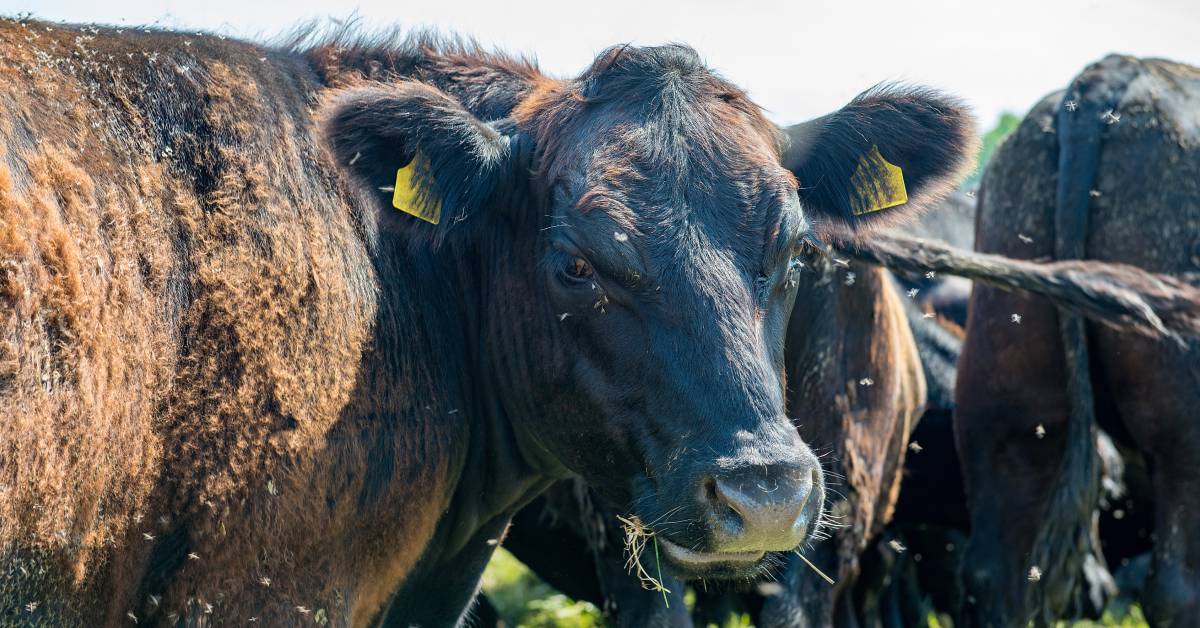Imagine you’re a cattle farmer striving to enhance the quality and productivity of your herd. You’ve invested time, resources, and passion into your operation, yet you find yourself at a crossroads: how can you ensure that your breeding decisions yield the desired outcomes?
Picture this: you have two bulls before you, each boasting impressive physical attributes. One is robust, with a sleek frame suggesting rapid growth potential, while the other exudes a sense of robustness, hinting at superior meat quality. How do you choose?
That’s when EPD (Expected Progeny Difference) in animal science comes in. In the cattle breeding industry, EPDs offer invaluable insights into the genetic potential of future offspring.
These numerical indicators aren’t just abstract figures but the keys to unlocking accelerated growth rates, heightened milk production, and optimized carcass characteristics. They are the linchpin of informed breeding decisions, empowering farmers to sculpt their herds precisely and purposefully.
At their core, EPDs represent a synthesis of data, lineage, and predictive analytics distilled into actionable metrics for breeders. By meticulously analyzing factors such as weight, height, and milk yield, scientists can peer into the genetic crystal ball and forecast the traits of future generations.
A positive EPD signifies superiority, a promise of offspring that surpasses the norm, while a negative value hints at areas for improvement. Accompanied by accuracy scores, these metrics offer a glimpse into the certainty of predictions, instilling farmers the confidence to make bold decisions with conviction.
With EPD (Expected Progeny Difference) in animal science, breeders can easily navigate the complex terrain of genetic diversity, selecting a breeding stock that thrives and propels their herds toward more excellent health, vigor, and profitability.
In this blog on EPD (Expected Progeny Difference) in animal science, we delve into the heart of modern breeding practices, uncovering the power of predictive analytics to revolutionize how we shape our livestock.
What are EPDs?
EPD (Expected Progeny Difference) in animal science is a numerical estimate that predicts the average performance of an animal’s offspring regarding specific traits crucial in animal breeding.
These predictions are derived from a meticulous analysis of various data points. Information about the animal, including its physical characteristics and performance metrics, such as weight, height, milk yield, and other relevant traits, is collected.
This data serves as the foundation for understanding the animal’s genetic potential. However, EPD (Expected Progeny Difference) in an animal doesn’t stop at individual data points; it encompasses the animal’s genetic heritage.
Information about the animal’s relatives, particularly its parents and progeny, significantly shapes the EPD (Expected Progeny Difference) in Animal Science. By examining relatives’ performance, breeders can gain insights into the hereditary traits passed down through generations.
Moreover, EPDs don’t operate in isolation; they are calculated within the context of the breed. Performance data from a broader pool of animals within the same breed are factored in, allowing for comparisons and establishing breed-specific benchmarks.
Benefits of Using EPD (Expected Progeny Difference) in Animal Science
EPDs aren’t just numbers on a page; they’re the catalysts for transformation within the world of animal breeding, offering benefits such as:
Improved Genetic Selection
The EPDs are the luminaries of genetic prowess, identifying the right direction for developing improved breeding animals.
This way, breeders can fast-track genetic gains in their populations mainly due to selective breeding of animals with desirable qualities, including, but not limited to, marker traits like growth rate, feed conversion, and milk yield.
This sought-after process ensures that every generation produced is better off than the past, providing a raw deal for improvement and excellence.
Increased Productivity
EPDs are the stars that help farmers lead their herds to increased production and farm efficiency. Using animals with high EPDs for growth rate, feed intake, and milk production results in an appreciable increase in a herd’s total productivity.
From early maturing cattle to feed-efficient cows, high dairy production, or any other genotyped trait, EPDs allow breeders to get the best out of their animals, doubling productivity to unbelievable heights.
Enhanced Marketability
The mere fact that cattle with positive scores in the most appreciated categories are not only assets but assets valued at the marketplace. Consumers use animals with excellent genetics to get their descendants’ coveted quality.
Whether those steers grow faster, provide more milk for the dairy industry, or have those characteristics, EPDs increase their marketability, increase the value of the animal, and raise the level of the breeder in the cattle industry.
Reduced Production Costs
EPDs are about output and input and are used to manage resources effectively. Using animals with favorable EPD values will significantly reduce feed costs, disease control, and veterinary expenses.
Efficient feed converters require less feed to achieve optimal growth, translating into savings on feed expenses. Likewise, animals endowed with robust disease-resistance traits alleviate the need for frequent veterinary interventions, reducing healthcare costs and ensuring a healthier, more resilient herd.
EPD Categories
EPD (Expected Progeny Difference) in animal science is classified according to specific attributes. It focuses on a defined matrix for assessing animals within a breed and choosing them based on specific genetic tendencies in several directions.
These categories include a wide array of characters’ attributes essential for various features of cattle farming. Here are some common EPD categories, along with brief descriptions of each:
Growth Traits
The category presents sexual dimorphic characteristics associated with the cattle’s phenotype growth process from birth to maturity. Standard EPDs for growth are birth weight, weaning weight, yearling weight, and other weights such as average daily gain.
Maternal Traits
Maternal traits are essential for achieving reproductive success and optimal maternal abilities in cows. EPDs in this category include milk production, the ability of a cow to calve easily, and weaning weight, which depicts the ability of an offspring to gain weight during the nursing period.
Carcass Traits
Carcass traits are essential attributes that help establish the quality and composition of the beef from cattle. Carcass EPDs are developed to estimate traits on the ribs such as rib-eye area, which is a measure of muscling, marbling score amount of fat within muscles, and carcass weight EPDs to give information about the quality and yield of the progeny’s meat.
Reproductive Traits
Reproductive traits are essential for a thriving, fruitful herd. The EPDs in this category measure characteristics such as scrotal circumference, heifer pregnancy within a given season, stability, or the cow’s likelihood of staying within the breeding herd in the next production year or years.
Efficiency Traits
Resource utilization and feed conversion efficiency are significant characteristics of present-day cattle production systems. EPDs for efficiency traits may, for instance, incorporate feed intake, residual feed intake (the difference in feed intake between an animal and a reference animal), and feed conversion ratio, which is the feed needed to produce one unit of output.
Structural Traits
Conformation and other structural characteristics are critical in cattle health, production, and breeding. Some of these EPDs are in the category of sizes and profiles, including frame score, which is part of the cattle’s size and skeletal structure.
Foot angle deals with the angle of the foot surface to the ground, affecting mobility, conscription, and foot health. Lastly, the udder score is more important in cows to assess the quality of the udder for lactation and calf rearing.
Understanding Different EPD Traits
Whether selecting breeding stock or managing herd health, EPDs provide valuable insights into genetic potential and guide strategic breeding and management practices. Here’s an overview of different EPD (Expected Progeny Difference) in animal science traits:

Interpreting EPD Values
EPD value analysis is as complicated as solving a puzzle that opens the window into the heredity of livestock. Here’s a guide to help decode EPD numbers and their implications for breeding decisions:
Deciphering EPD Numbers
EPD (Expected Progeny Difference) in animal science stands for expected performance difference, which reflects an animal’s likelihood to perform in a particular way concerning a given trait relative to the breed average.
For example, 50 for weaning weight means the bull’s calves will be expected to be 50 pounds heavier at weaning than calves born at a bull with 0 for weaning weight.
Positive vs. Negative EPDs
EPDs that have positive numbers imply that, in terms of genetic disposition, a population has enhanced ability for a particular characteristic like growth or milk production.
Negative EPD values will be below the breed average, which shows that the genetic potential can be considered poor.
For example, an EPD of + 10 for maternal milk means that the daughters of this bull will be 10 pounds heavier on average per day than daughters of a bull with an EPD of 0 for maternal milk.
Percentile Rankings
Percentile rankings also offer a context as they quantify animals’ genetic value based on their ranking against animals from the same genetic population, which is the breed.
For example, a bull’s weaning weight EPD implies that the bull has better genetic traits than 90% of the bulls in the breed, as per the weight genetics statistics.
Percentile rankings involve tracking superior animals that perform well in specific characteristics of other animals.
Reliability and Accuracy
EPDs are associated with accuracy figures that represent the quality of the forecast. The accuracy values also increase as the EPD (Expected Progeny Difference) in animal science estimates have more data from the animal and its relatives.
Since EPDs indicate genetic merit, breeders should focus on the indices with the highest accuracy, as they will give better estimates of genetic worth.
Example Comparison
Now, let’s take two bulls within the same breed, say bull A and bull B, both having EPDs on weaning weight. Bull A’s weaning weight EPD is +45, while Bull B, on the other hand, has an EPD of +30.
- Bull A: The EPD for 200 weaning weight equals +45, indicating that his calves will be 45 pounds heavier at weaning age compared to the breed’s average.
- Bull B: His calf weights suggest that they would be about 30 pounds heavier than the EPD expectations for weaning weight at weaning.
Looking at the weaning weight EPD, we find out that Bull A has a higher weaning weight EPP, meaning that the young offspring of this Bull are expected to be heavier than the young offspring of Bull B.
However, to understand the range and quality of the EPDs provided and the accuracy of the prediction, it will be essential to consider the accuracy values for each EPD (Expected Progeny Difference) in animal science, which is used for breeding decisions.
Selecting Cattle Based on EPDs
When using EPDs for the selection of cattle, the following must done:
Defining Clear Breeding Goals
The use of EPDs requires setting clear breeding goals. These goals are general objectives that help manage breeding decisions and frame the future course of the herd’s development.
In that sense, it does not matter whether the goals are to boost growth rates, milk yield, or carcass quality; it is crucial to have clear objectives to ensure that the selection criteria mirror them.
Considering Trait Trade-offs
It is crucial to ensure that genomic traits can interact with EPDs and selection priorities. For example, where greater emphasis is placed on high weaning weight EPDs, the subsequent consequence may be faster growth rates of calves and potentially more significant problems with birth weight and calving.
Thus, when selecting the priorities of a given breed, the breeder has to consider that each of the advantageous traits comes with certain more or less complex problems and how it would affect the income and well-being of the whole herd.
Evaluating Additional Factors
EPDs are not the only evaluation tool; other phenotypical characteristics, structural soundness, temperament, and health records are equally essential for choosing the appropriate animals.
Although the EPD (Expected Progeny Difference) in animal science is a valuable tool in determining a potential animal’s capabilities, these extra factors help to gain a better overall picture of the animal and to improve the overall function of the herd.
Utilizing Percentile Rankings
Using percentile rankings about a breed enables assessing the performance of animals to determine which performs better than the rest within the same breed.
By comparing EPDs to percentile rankings, breeders are provided with information about the relative breeding worth within the frame of reference of breed, which is beneficial in picking superior animals to breed for the next generations.
Emphasizing Accuracy Values
Moreover, assessing the accuracy values regarding EPDs to uncover how much accuracy should be applied to breeding decisions is crucial.
When EPDs are accompanied by greater accuracy, this increases confidence in the prediction since it is calculated with a broader base derived from the animal and its progeny.
This way, only more accurate EPDs can provide more accurate predictions of animals’ genetic potential and avoid errors in evaluating breeding worth.
Maintaining Genetic Diversity
Maintaining genetic diversity within the herd is paramount for long-term sustainability and resilience against environmental challenges.
While selecting animals based on desirable EPDs is essential for genetic improvement, preserving genetic variability within the population safeguards against inbreeding and enhances adaptability to changing conditions.
Alternatives to EPDs
Alternative methods for animal selection are:
1. Phenotypic Selection
Phenotypic selection selects breeding stock, considering the animal’s observable traits and performance. Breeders directly measure characteristics such as size, conformation, milk yield, and temperament.
Phenotypic selection is more straightforward and can be done practically; however, certain factors affecting phenotype may include options that do not reflect an animal’s genotype.
2. Pedigree Analysis
The pedigree analysis involves using an animal’s family background to lead on its ability to transmit preferred qualities to its progeny.
Thus, using the experience of animal selection based on the indication of certain stock traits, breeders can predict the probabilities of the specific characteristics.
Pedigree analysis is convenient when an individual animal’s performance records are incomplete or not available at all. However, it does not cover change by recombination, while prediction is influenced by the quality and, especially, completeness of pedigree records.
Limitations of Using EPDs
By acknowledging and understanding the limitations of EPDs, producers can make informed breeding decisions that optimize both genetic potential and overall animal well-being. However, here are the limitations of using EPDs:
Accuracy and Reliability
EPDs represent genetic predictions derived from available data and models. Therefore, they depend on factors such as the quality of the data, information on the pedigree, and the relationships. Fluctuations in these factors can affect the reliability of EPDs, and therefore, there is always a possibility of errors in estimating Genetic merit.
Environmental Factors
EPDs do not factor in environmental factors, such as feeding regimens and disease challenges, that can impact the animal’s performance.
These environmental effects may not be considered when developing EPDs, leading to situations where the actual environmental circumstances deviate from the EPD calculations and inadequate breeding decisions are made.
Limited Trait Coverage
Even though EPDs used at the time were derived from economically essential traits, several traits of interest have not yet been incorporated into the evaluation.
This limited trait coverage could hamper breeders’ efforts to resolve other aspects or issues regarding overall herd management and genetic enhancement.
Some of these performance factors may require additional records and phenotypic data to make up for the limitations of EPD data in comprehensive herd management.
The Future of EPDs in Animal Breeding
It is deemed that EPD technology will experience continuous improvements in the future, and it will open a broad spectrum for the cattle industry. As we look ahead, several key trends are expected to shape the evolution of EPDs and their role in animal breeding:
Genomic Selection
The EPD (Expected Progeny Difference) in animal science is quickly becoming a reliable predictor as better genomic technologies and DNA sequencing remain more accurate in the future. Genomic selection helps to estimate an animal’s breeding value directly, thereby increasing the rate of genetic improvement and accuracy of selection.
Breeders then make selections that increase the genetic value of the herds based on specific genetic markers of desirable traits.
Integration of Environmental Data
Some EPD models may include climate, terrain, and management practices to quantify the interactions between genotypes and environments.
This integration will help the producer make the right breeding decision, which, given the production parameter setting, could enhance the animal’s performance.
Knowing how genetics and environments are related, breeders can create improved and sustainable animal populations.
Enhanced Data Analytics
The proliferation of data analytic approaches and machine learning tools will enhance the ability to work with large genomic and phenotypic data sets.
Predictive modeling will lead to new approaches to predicting genetic potential and choosing superior breeding animals.
With the help of formal methods of analysis, breeders can gain a deeper understanding of rather extensive material and thus use more efficient breeding methods.
Conclusion
Understanding EPD (Expected Progeny Difference) in animal science offers a transformative lens into breeding decisions, guiding the selection of breeding stock with clarity and purpose.
As advancements in genomic selection and data analytics propel EPDs into the future, breeders can confidently navigate the complex landscape of genetic diversity, ensuring the prosperity and sustainability of their herds.
EPD (Expected Progeny Difference) in animals will continue to empower breeders to make informed decisions that improve their herds’ overall performance, resilience, and sustainability.
As we embrace these innovations, EPD (Expected Progeny Difference) in animals will remain a cornerstone of modern animal breeding, contributing to the ongoing evolution and success of the cattle industry.








